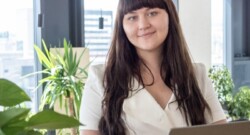Author: Tamara Mrázová
Šimon Popovič: Start using LinkedIn now! Young people are still a rare commodity on it :)
Passion for science, a fervour for education, and a willingness to communicate. It is the combination of these qualities that leads us to Šimon Popovič. The founder of the project “VEDA V KOCKE” and one of the most successful contributors on the social network LinkedIn is only 16 years old, but his mindset sets him apart significantly from his peers. What motivated you to start you project “VEDA V KOCKE”? The project VEDA V KOCKE aims to popularize science among young people and create interactive learning experiences for them. Currently, we are doing this through content on social media, where we present interesting topics from various scientific fields to our followers. We try to explain even the most complex topics briefly and simply. Since we write in the language of our generation and incorporate elements of humor, we come across more naturally to our peers. WE STRIVE TO EDUCATE IN AN INTERESTING WAY. Imagine Einstein putting on a pair of golden glasses and, instead of reciting a technical formula, starts explaining his theory of relativity to young people using simple sentences and humour. And that’s exactly what we aim to do—explain even complex or seemingly difficult topics in a simple and engaging way. Of course, when you simplify, you sometimes have to omit certain details, so you technically don’t tell the whole “truth.” Everything is inherently complex, and to understand it thoroughly, you need to study the subject for several years. I was inspired to start by watching Vedátor—Samuel Kováčik. He was one of the first “pioneers” to start popularizing science in Slovakia. I realized that not only does science fascinate me, but I also really enjoy explaining it to others. So, I decided to start doing something similar. Over the years, a lot has changed—VEDA V KOCKE has grown into a team of people, we’ve built an audience of over 4,000 followers on Instagram, we’re expanding to other social media platforms, and we have more plans for the future. What’s it like to be in the business world at a young age? It’s incredibly rewarding. I’m thrilled to be surrounded by people who want to achieve and change things. I also deeply appreciate that they not only support me but also share their experiences and advice. And since in Slovakia “everyone knows everyone,” it’s always an endless wave of networking. (laughter) Do you encounter generational prejudices? Honestly, I haven’t encountered any generational prejudice where someone older has dismissed me just because of my age. However, generational prejudices are still quite common. I believe the problem exists on both sides. Young people today can leverage technology and the online world to gain a tremendous amount of knowledge and learn a lot. Additionally, when the right conditions are created for us, we can be incredibly creative and innovative. We are always looking for something new and view things with an innovative mindset; the question “How can we improve something?” constantly flows through the minds of young inventors. On the other hand, let’s be honest, a lot of things simply require life experience. As we get older, we go through more experiences, victories, and failures, from which we can learn. Sometimes, the younger generation doesn’t respect this aspect. Do you like social media? Why do you enjoy LinkedIn? After each use, I delete the social media app. If I want to use it again, I have to download it and enter a lengthy password. Then, I delete it again. My peers don’t understand this at all, but this habit that I’ve developed over the last two years has helped me reduce my average time on social media from 8 to 6 hours a day to just a few minutes. Social media, in my opinion, is a double-edged sword. On one hand, it’s an amazing tool through which we can share our thoughts, help others, and meet new people. On the other hand, it has a dark side: it can facilitate the spread of aggression, the dissemination of alarmist news without verification or context, and it can quickly lead us into social bubbles that are hard to escape from. Of course, there are many profiles on social media that can teach us something valuable. It’s fine to entertain ourselves with “funny” videos, but we shouldn’t overdo it. It’s each person’s responsibility to use social media as meaningfully as possible and behave considerately while enjoying the fun. That’s also why I like LinkedIn. You won’t find vulgar arguments in the comments there. But you can easily connect with other professionals from whom you can not only learn a lot but, ideally, who might even offer you a job. It’s like putting your resume in a bottle and throwing it into the ocean—you never know who might find it and open new doors in your life. (laughter) WE SHOULD BE MORE MINDFUL OF HOW MUCH TIME WE’RE SACRIFICING TO THESE APPS- INCLUDING MYSELF. How do you perceive generation Z? Of course, every generation has its own challenges, problems, and joys. However, I think that in many ways, Generation Z has it tougher. I once came across the idea that, at a time when humanity should be at its best—we have enough food, water, and the internet connects us with the entire world—we paradoxically seem to be at our worst. And I believe there’s some truth to that. As a generation, we have immense opportunities, but there are so many that we struggle to choose. We have access to news from every corner of the world, but often only the negative ones reach us, which can put us in a bad mood. We have a vast amount of resources at our disposal for information. Social media connects us with friends but also amplifies our tendency to focus on superficial matters, constantly compare ourselves to others, and strive to be perfect in everything. On the other hand, we’re a generation full of creativity, new ideas, and a desire to improve things. If we help each other and create good conditions around us, I’m confident we can handle anything. (laughter) What message would you give to your generation Šimon? If I had to give you one piece of advice, it would be: delete your social media. Or at least regulate your time on them a bit. You’ll find that not only do you get more done, but you’ll also feel better about yourself. (laughter)
Things you probably did not know about the Paris Olympic Games 2024
The Summer Olympics 2024 in Paris are on! From the 26th of July, we can watch and support more than 10 000 athletes that compete to get their hands on the medals. Check these interesting facts worth knowing about the Paris Olympics 2024. Tahiti is the new Paris While Paris remains the host city, 16 other cities across France host some sporting events. The most unique competition is considered to be surfing, which takes place in the French territory of Tahiti. This location is 15 000km away from Paris and is the furthest competition held outside the host city. However, the legendary Teahupo’o waves of the Pacific Ocean are worth the distance for all athletes. Gender equality This year’s Olympics are the first in history with an equal number of male and female athletes participating. Out of all 10 500 athletes, 5 250 are men and 5 250 are women. Inclusion of the Eiffel Tower This iconic monument will have two main roles in the Paris 2024 Olympics. Firstly, beach volleyball will be held in a temporary outdoor arena outside the Eiffel Tower. Secondly, the medals will be decorated with original iron from the tower so that all medal winners can take a piece of Paris home with them. 100th anniversary Paris hosted the Olympic Games for the very first time in 1900 and then later in 1924. This means that the 2024 Olympics mean a return to Paris after exactly 100 years. Additionally, Paris will become the second capital city to host the Olympics three times, right after London. New way of opening This year’s Opening ceremony took place on the river Seine. It was for the first time in history that the opening of the Olympics was not held in a stadium. We could see athletes enter this sporting event in a colourful parade through the capital city of France. Catching up with the stars Champions Park, located in front of the Eiffel Tower, allows spectators to meet up with the Olympic athletes as well as enjoy various performances by artists. Entry is free in order to offer the best experience. Moreover, visitors can enjoy live broadcasting of major sporting events every night. Temporary venues Paris set up 7 venues during the Olympic Games and 5 venues during the Paralympic Games. These venues are only temporary and will be dismantled after the Games. This allowed Paris to host some events in the heart of the city. The main effort was to protect trees and vegetated areas. Coming together to help The Paris 2024 Olympics are supported by 45 000 volunteers, who were able to apply through the official site. Thanks to their enthusiasm to help, an unforgettable experience and smooth organisation are ensured. Torch as a symbolic object The torch has been a message of unity and peace since the very first Olympic Games. To be exact with the origin, the Olympic Flame crossed the Mediterranean Sea before officially arriving in France. After two weeks from the start of the Games, the Olympic Flame will be put out, but the torch will continue to be lit. The Phryges Phrygian caps are the mascots of Paris 2024. The Phrygian cap is a symbol of freedom and forms part of French history. Records show that this piece of clothing was worn during the construction of Paris’ Notre-Dame cathedral, during the Revolution during construction of the Eiffel Tower, and during the Paris 1924 Olympic Games.
A young Slovak woman named Daniela fell in love with IT: “I created my first computer game back in elementary school.”
The world of information technology (IT) is a dynamic and highly popular field in today’s modern world. However, there is an interesting demographic trend in the IT sector—there are more men working in this field than women. Despite significant progress made by women in recent years and an increase in their representation in IT, they still remain a minority compared to men. Speaking from her own experience, Daniela Chovancová, fell in love with IT. Ever since she was little, she designed and programmed her first computer games, and at the age of 18, she even started her own project and began offering her services. She believes that IT is not an environment exclusively for men, as gender does not play a crucial role here. According to Daniela, IT offers numerous opportunities where creativity, empathy, and the right mindset are what matter most. Women can shine in this field. She shared more about her experiences in an interview. When did you realise that IT is the way you want to follow? Since elementary school, I’ve enjoyed creativity combined with technology. I was also drawn to entrepreneurship, and the idea of creating my own projects using IT skills seemed like the perfect combination. It helped me turn my ideas into reality and overcome various barriers. I explored the possibilities of graphic design, development, and marketing, and discovered that designing and developing websites and applications perfectly align with my interests. Choosing to study at a technical high school specializing in electrical engineering greatly helped my development. It was a real challenge for me, as I didn’t always get straight A’s in elementary school. However, I came to understand what IT is all about, and I also received an excellent foundation in economics for my future business ventures. How did you develop your skills later on? Even before high school, I realized that IT isn’t just about numbers and data; it requires logic, creative thinking, and entrepreneurial ideas. That understanding drove me to find ways to improve my skills. It all led to the point where, at the age of 15, I created my first computer game. Throughout high school, I actively participated in various courses and workshops. It’s the best way to gain practical experience. I had C’s in math and physics in school. This created fear and doubts among those around me, but I felt that working in IT wasn’t just about numbers. Being a woman, did anyone discourage you from pursuing IT? Have you encountered any gender-based prejudice? Yes, I think this is a broader societal issue that affects various technical fields, not just intelligent technologies. Even in school, as almost the only girl among all those boys, I stood out. People were surprised and wondered if I had mistaken the school. However, I managed to become the first woman to receive an award from the school board. I proved to myself that if you find something that truly fulfills you, you can take it further than you might think. Of course, you can’t excel at everything, as was the case for me with physics. (laughs) How did your career journey evolve? Since I was 15, I worked for small and medium-sized businesses, where I developed my IT skills as well as my overall understanding of business. It’s the best way to gain practical experience—solving real problems, proposing improvements, and seeing the impact of my actions. Working in smaller and medium-sized companies often provides exposure to various IT areas. For one of these companies, I created marketing content, set up advertising campaigns, and worked on graphic design. Over time, I identified that their e-commerce site was lacking in quality, so I decided to redesign and program a new one. These experiences allowed me to work on different projects and gain a comprehensive role in this field. At 18, I started my own business. I knew what I wanted and was eager to create something of my own. Due to prejudices about my age and even my gender, I knew I couldn’t present myself solely as an 18-year-old student. My brand wouldn’t have had a chance to grow. So, I gave it a name and employed myself. 🙂 Does future of IT involve women? Absolutely. Women and men have their own qualities and strengths that they naturally bring to the table—let’s not try to be the same, but equal, and see it as a great opportunity for collaboration and complementing each other. We don’t need to rely on stereotypes, as even men can sometimes fear this sector. For instance, not everyone is a math person like I am, but they might discover their creativity and passion for technology. Working in IT offers flexible conditions and the ability to create a free way of working, which can be very beneficial for women at different stages of life. Women and men have their own qualities and strengths that they naturally gravitate towards—let’s not try to be the same, but equal, and view it as a great opportunity for collaboration and complementing each other.
These viral recipes have taken the internet by storm. Do you know them?
Almost everyday, a new viral recipe spreading on platforms like TikTok, Instagram, YouTube, and Pinterest bring new culinary inspirations right into our kitchens. Whether it’s simple and quick dishes that even beginners can master or something more gourmet, the internet offers countless ideas to try at home. Looking for cooking inspiration? In this article, we’ll check out recipes that almost everyone around the world has tried! Feta Pasta This famous recipe caught the attention of chefs mainly thanks to TikTok. It involves a pretty simple pasta preparation, with a special twist in the sauce. In a baking dish, you add olive oil, cherry tomatoes, garlic cloves, and a whole block of feta cheese. You let this mixture bake until softened. Meanwhile, you cook any type of pasta you like. When the baking dish is removed from the oven, mash everything well with a fork and mix it into a thick sauce. At this step, add seasoning and fresh tomatoes to taste. Be careful with the salt, as the feta provides plenty of salty flavour. Serve with fresh basil! 🙂 Green Goddess Salad TikToker Melissa won many of our hearts with this recipe. She put cabbage in the spotlight, enriching this beautiful green salad with a hefty dose of vitamins. The magic of preparing this salad lies in the chopping. Every ingredient needs to be chopped as finely as possible. To make it, you’ll need finely chopped cabbage, cucumber, green onions, and chives. If that’s not enough green for you, we’ll make a green dressing too. In a blender, add spinach, garlic, walnuts, salt, pepper, lemon juice, a teaspoon of vinegar, and for those who don’t mind a non-vegan version, some Parmesan cheese. Serve with tortilla chips. Classic French Toast Most of us have probably heard of the sweet treat called “French Toast” before. Let’s remind ourselves all of the magic about this classic French recipe together. To make these delicious French toasts, we’ll need some bread. The best choices are brioche, challah, or regular store-bought toast. In a bowl, mix together eggs, milk, cinnamon, and sugar. Dip the bread slices into this mixture, then fry them in a pan. Once they’re done, place the toasts on a paper towel to remove any excess oil. This sweet dish is traditionally served with maple syrup or honey, cinnamon, and fruit. However, a good jam or hazelnut spread also makes for a delicious choice. Every sweet tooth will be thankful for this recipe! 🙂
Nikola, as a Slovak, has been living in Spain for a few years now: “Spaniards live in the moment and don’t chase after everything like Slovaks do.”
Imagine waking up every day to the sound of flamenco guitars, with a view of the sun-drenched Mediterranean coast, and ordering a shrimp paella for lunch. This Spanish stereotype is something Slovak Nikola Noveková decided to experience firsthand when she moved to Spain to find work. But are these dreams as rosy as they seem? Nikola shares more about life in Spain in her article. Why did you decide to leave Slovakia? I’ve always dreamed of experiencing life abroad. At first, it was probably about the idea of “moving for a better life.” I’ve always been drawn to living outside of Slovakia, where I could feel happier and more alive—something I felt was lacking to some extent back home. Why Spain? The fact that I ended up moving to Spain was pure coincidence at this point. (laughs) I was working in Slovakia at an agency where I coordinated the Work and Travel USA program. In 2019, I participated in this program and experienced living abroad for the first time. I wanted to travel again to the USA in 2020 and 2021, but the pandemic situation prevented that. At that time, I had an intense urge to go somewhere for the summer, and I saw a post online that a company was looking for a fitness instructor for Mallorca. I thought to myself, this would be my dream job, especially since I’m a former dancer, I love yoga, and I’ve studied sports and dance. THAT’S HOW IT ALL STARTED. ALL OF A SUDDEN, ONE SUMMER TURNED INTO THREE YEARS. What is the biggest cultural difference between Spain and Slovakia? There are really a lot of differences. For example, meal times are quite distinct. People have breakfast around 11:00 AM, lunch is usually between 3:00 and 4:00 PM. Then, around 6:00 PM, they have what’s like our afternoon snack (called merienda), and dinner is typically around 10:00 PM, sometimes even later. The pace of life is also much slower, and people are generally very direct. They aren’t afraid to express their emotions openly, but they are also very friendly and communicative. Parties here have no age limit, so even my friends in their 30s and 32s go out to clubs anytime they like 🙂 You found love in Spain. What is it like to date outside your culture? Of course, there are differences, but we get along very well. At first, our paces were quite different, but at least I learned to slow down, because before that, I was always rushing around. Many Spaniards also don’t plan their future in detail. They don’t rush into marriage, having kids, or buying homes or apartments. When it happens, it happens 🙂 They live more in the present and don’t chase after everything like we do. They believe that everything will come in its own time. So, there’s usually no social pressure from society. To sum it up, my partner and I don’t really feel any extreme differences, but of course, it always depends on the people. THANKS TO MY PARTNER, I’VE LEARNED HOW TO SLOW DOWN. What would you recommend to those considering life in Spain? If you’re thinking about moving there long-term, I definitely recommend learning Spanish. You also need to have an open mind because life in Spain is different from what we’re used to, and the mentality of people is also different. There are different laws and rights, the healthcare system is different, and your lifestyle will change significantly. However, if you’re determined to move, like Spain, and are excited to try living here, I would wholeheartedly recommend it. Would you do it again? Do you regret any of it? I try to never regret anything that’s happened or my decisions. I admit I had a tough period in Spain, but I never thought about regretting my decision. On the contrary. Are you planning to get back to Slovakia? I can’t really answer that question yet, as I think about it mainly because I miss my family a lot. I would return for them. On the other hand, there’s still something keeping me here, and I’m not ready to leave. We’ll see. I’m like a Spaniard now, not planning too far into the future. I’m living in the present and will see what life brings 🙂 Spain has changed my life. It’s shown me that I’m capable of things I never believed I could do. I’ve had an amazing experience, changed my perspective on life, and learned a new language. If I could turn back time, I know I would do it again.
How to properly organize your time at work? A few tips to help you become more productive
Today’s fast-paced world often doesn’t give us a chance to stop and catch our breath. We spend our days overwhelmed with work and responsibilities, and time just slips away. One important step to incorporate into our daily routine is planning. If you’re looking for tips on how to manage your time effectively while working, you’re in the right place. By properly organizing our work schedule, we can save several valuable hours each week, which we can use to our advantage. Whether it’s improving our hobbies, spending active time with loved ones, or simply relaxing with a good book, finding a bit of time for ourselves always pays off. Eliminate distractions We’ve all been there. You sit down at your computer to get some work done, but staying focused becomes a challenge. Everything around you seems to distract you. Whether it’s the music playing in your office, chatting colleagues, or the noise of traffic outside, try to minimize these distractions. If necessary, use earplugs or put on headphones with calming music. White noise can help adults concentrate just as much as it helps babies fall asleep. Clean your desk Let’s stay on the topic of distractions for a bit longer. This time, it’s not just about noise, but visuals as well. Your workspace and the desk you work at play a crucial role. Remove anything that isn’t related to your work. Various decorations and unnecessary items can divert your attention away from the screen. Some studies suggest that the best desk is one that only has your laptop and essentials like a lamp, a planner, or a glass of water. Work in Proper Intervals During an eight-hour workday, it’s tough to keep our focus from drifting constantly. Try using interval methods. Simply given, alternate between periods of intense work and short breaks. For every half-hour of focused work, take a 5-minute break to relax and shift your attention elsewhere. This way, your brain will learn when to be fully engaged and when to relax. Your efficiency will increase significantly. The length of the work interval varies for each person, but it should never be less than 30 minutes. Plan your breaks. Value Feedback Reflect. Ask yourself: Did I work better than last month? If so, what helped me improve? If not, why, and where did I fall short? Seek feedback from those who motivate you. Whether it’s your boss, a client, or a colleague, ask them for their input. While recognizing our strengths is important, it’s also beneficial to see ourselves through someone else’s eyes from time to time. You might learn things about yourself that you wouldn’t have noticed otherwise, which can only make you stronger. If the feedback is negative, at least you’ll know what to work on in the future. Set milestones It’s really hard to work without motivation. That’s why it’s good to set small, manageable goals that will motivate you towards a bigger objective. Reward yourself. A great tip is to treat yourself to your morning coffee only after you’ve completed the most annoying task of the day. The same goes for your favorite sweets or the occasional lunch delivery you enjoy at work. Whether it’s small steps or something bigger, remember that we’re not machines. Life is meant to be lived, not just survived 🙂 EVEN WHEN WORKING, SURROUND YOURSELF WITH WHAT YOU LOVE. BE KIND TO YOURSELF!
5 unusual sports you probably haven’t heard of yet
Sports are a big part of our lives. After the pandemic, many of us realized how precious our active time can be. It’s often about staying in shape, keeping fit, or living a healthy lifestyle. Sports are also a key part of every culture. In this article, you’ll discover some unusual sports you might not know about, but which are totally normal in other parts of the world. Quidditch Remember the wizarding saga Harry Potter? Quidditch is the unique sport many of us associate with this film series. In the movies, we see wizards flying around the Quidditch pitch on broomsticks, trying to score by getting a ball through the opponent’s hoop. What many might not know is that this sport has made its way into the real world. Unfortunately, without the flying broomsticks 🙂 In Slovakia, Quidditch started being played in 2015, and there is now even an international competitive version. It’s a mixed-gender contact sport where both men and women participate. Each team consists of seven players who, as you might have guessed, run around the field with a broom between their legs. These aren’t traditional wooden brooms but flexible plastic replicas. Bossaball How about taking a trip to Brazil? That’s where the sport of bossaball took off, a unique blend of several globally known sports. In bossaball, you’ll find elements of soccer, gymnastics, and volleyball, all set to modern music. Bossaball is played on an inflatable court with a trampoline in the middle. Each side of the net has a team of three or two players. One player spends the game bouncing on the trampoline and spiking the ball, while the other two players handle passes and set up shots for the bouncer. Chessboxing If you thought no sport could surprise you with its absurdity, let us introduce you to chessboxing. Yes, this sport is exactly what its name suggests. A combination of chess and boxing, two of the most opposite sports you can imagine. Wondering about the game strategy? Players face off in short rounds lasting three minutes each. A round of chess alternates with a round of boxing. Would you try such a sport? Which extreme of this sport do you prefer? Joggling It turns out that combining different sports is a popular trend around the world. A great example is “joggling,” which combines jogging and juggling. That’s right, jogglers run on a track while juggling. Maybe they found plain running a bit too boring. Cheese rolling In the UK, they dive right in—literally! The annual Cheese Rolling Festival has been a tradition for years and is an incredible spectacle. Dozens of people first climb up a steep hill. Then, they release a wheel of cheese from the top. That’s when the fun begins. All the participants start chasing the cheese headlong down the hill. Calling it running is a bit of a stretch, given how steep the hill is. There are plenty of falls, tumbles, and rolling around. It’s probably no surprise to readers that 95% of the participants in this sport are men. They’re always fueled by adrenaline and, as is customary in England, some good English beer flowing through their veins 🙂
Have you heared of Camino de Santiago de Compostela?
Thousands of kilometres of paths, traveled by millions of pilgrims, all with the same goal—Santiago de Compostela. It’s one of the most famous pilgrimages in the world, leading all the way to the northwestern tip of Spain. Do you know what the Camino is? Have you heard about it? What exactly is the Camino de Santiago? The Camino de Santiago, also known as the Way of St. James, is a network of pilgrimage routes leading to the tomb of Saint James in the cathedral of Santiago de Compostela in northwestern Spain. This centuries-old pilgrimage path, stretching across Western Europe, attracts adventurers, spiritual seekers, and culture enthusiasts alike. This scenic route, known as “the Camino,” has a magnetic pull that draws pilgrims from all over the world. Pilgrims, known as “peregrinos” travel hundreds of kilometres each year, making their way to the city of Santiago in northern Spain. They carry backpacks with all their essentials. Beyond the physical challenge, the Camino represents a profound spiritual journey, offering participants a chance to connect with history, nature, and most importantly, themselves. There’s more than one There are several main pilgrimage routes that lead to Santiago. Camino Francés: The most popular route, approximately 780 kilometers long, starts in France and ends in Santiago de Compostela. Camino Portugués: This route starts in Portugal, usually from Lisbon or Porto, and is the second most popular route. Camino del Norte: A route that runs along the northern coast of Spain. Camino Primitivo: The oldest route, starting from Oviedo, and considered the most challenging due to its terrain. Via de la Plata (Silver Route): This route starts from Seville in southern Spain. How long does it take? The duration of the Camino de Santiago pilgrimage depends on various factors, such as the specific route chosen, the physical condition of the pilgrim, their walking pace, and the number of days planned for rest and sightseeing. Pilgrims also need to consider the weather, which can often extend and complicate the journey. The duration of each route is very individual. On average, however, the Camino takes about a month. One of the longest routes, the Via de la Plata (Silver Route), can take up to two months to complete. Not every pilgrim can afford to spend two months a year on this pilgrimage, so shorter routes, which have developed from the five main routes, have become popular. For example, the Camino Inglés (English Way) takes about a week to complete, while the Camino Finisterre requires only 5 days. Facts you might not have known about the Camino La concha (The Scallop Shell): The scallop shell of Saint James is the symbol of the pilgrim’s journey. Pilgrims follow these painted shells along their path, ensuring they stay on the right route. Los albergues: These are modest hostels where pilgrims stay overnight. Their daily route typically leads from one albergue to another, where they can wash their clothes if needed and spend the night in simple beds. Pilgrims do not expect luxury. Stamps: At the end of each day, pilgrims can find a place in the local church to receive a stamp for their journey. These stamps are collected in a travel diary, which they purchase at the start of their pilgrimage. UNESCO: Some Camino de Santiago routes are listed as UNESCO World Heritage Sites, including the French Way (Camino Francés) and the Northern Way (Camino del Norte). Compostela: This is the certificate that pilgrims receive after completing at least 100 kilometers on foot or 200 kilometers by bike to Santiago de Compostela. Crowds: In 2022, more than 400,000 pilgrims completed the journey. The Camino is gaining popularity each year, and it is estimated to attract even more tourists in the future. The journey is a unique personal experience for everyone, and pilgrims often speak of the spiritual or inner changes this path brings. Whether you embark on this journey alone or with loved ones, you will surely find what you are searching for. Or at least, discover how to achieve it. During the endless kilometers your feet will traverse, you’ll give your mind the perfect space for deep reflection. “HE WHO COMES TO THE CAMINO WITH A HEAVY HEART WILL LEAVE WITH A LIGHT SOUL.”








